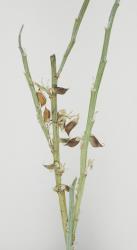- Taxon
- Gallery
- ≡ Huttonella curta (Petrie) Kirk, Stud. Fl. New Zealand 116 (1899)
- = Carmichaelia diffusa Petrie, Trans. New Zealand Inst. 25: 272 (1892 [1893])
- = Carmichaelia curta var. glabra G.Simpson, Trans. Roy. Soc. New Zealand 75: 282 (1945)
Spreading, sprawling, sparsely branched shrub up to 0.5-1 × 1-2(-2.5) m broad; in disturbed habitats frequently suckering and forming patches up to 0.25 m tall and 1-1.5 m broad. Branches slender, decumbent, spreading, occasionally erect, arching and sprawling outwards, 10- 20 mm × 0.5-1.2 m. Cladodes linear, striate, slender, subterete to terete, olive green to brown-green, covered with purplish bloom when young, often brown or bronze in winter, becoming glabrous with age, 150-450 × 2-2.5 mm; leaf nodes 9-22. Leaves 1- 7-foliolate, fleshy; adaxial surfaces mottled greygreen or brown-green, hairy; abaxial surfaces pale green, hairy; apex emarginate to retuse; base cuneate to obtuse; margin sparsely hairy. Single or terminal leaflet broad-elliptic to ovate, 5-12 × 3-7 mm. Lateral leaflets broad-elliptic, ovate, or obovate, 3-4 × 1.75-2.5 mm; petiole hairy, 10-12 mm long; petiolule glabrous, 0.1-0.3 mm long. Leaves on cladodes reduced to a scale, triangular, glabrous, c. 2 mm long; apex acute. Stipules free, triangular to narrow-triangular, hairy or glabrous, 1.0-1.2 × c. 1.0 mm; apex acute; margin hairy or glabrous. Inflorescence a raceme, l(-2) per node, each with 9-11 flowers. Peduncle glabrous, covered with purplish bloom when young, 15-20 mm long. Bracts narrow-triangular, glabrous, c. 1 mm long; apex acute, with a tuft of hairs; margin sparsely hairy. Pedicel glabrous, reddish in colour, 2-3 mm long. Bracteoles at base of receptacle, narrow-triangular, flushed with red, 0.25-0.5 mm long; apex acute, with tuft of hairs; margin sparsely hairy. Calyx campanulate, 2.5-3 × c. 2 mm; inner and outer surfaces glabrous, green, usually flushed with red. Calyx lobes triangular, flushed red, c. 0.5 mm long; apex acute; margin hairy. Bud purple or white. Standard obovate, spreading above wings and keel, 3-4 × 3-4 mm; distal and central areas of adaxial and abaxial surfaces with purple blotch, proximal area pale green, sometimes purple-veined; apex retuse; margins white and recurved; claw pale green, c. 1.5 mm long. Wings broad-oblong, longer than keel, 3.5—4 × 1.5- 2 mm; distal and central areas of adaxial and abaxial surfaces white, with proximal area pale green, sometimes purple-veined; auricle rounded, pale green, c. 0.25 mm long; claw pale green, 1-1.25 mm long. Keel (Fig. IB) 3.5^.5 × c. 1.5 mm; distal area of adaxial and abaxial surfaces purple, central area white, proximal area pale green; auricle rounded, white, c. 0.25 mm long; claw pale green, c. 2 mm long. Stamens 3—4 mm long; lower filaments almost fully connate - alternate anthers subsessile and with free parts of filaments 0.2 mm long. Pistil similar length to stamens, c. 4 mm long; style with a ring of hairs below stigma; ovules 5-7(-8). Pod shortobovate or broad-elliptic, occasionally almost orbicular, dorsally compressed, valves inflated, brown or straw-coloured, indehiscent, 4—5.5 × 2-2.5 mm; beak on adaxial suture, straight or only slightly curved, stout, pungent, 1-2(-2.5) mm long. Seeds oblong-reniform, 1-2 per pod, olive green or orangebrown with black mottling, 1.5-2 × 1.25-1.5 mm. FL Oct-Feb(-Jul), FT Jan-Aug.
[Reproduced from Heenan (1995, New Zealand J. Bot. 33: 455-475) with permission from The Royal Society of New Zealand.]




